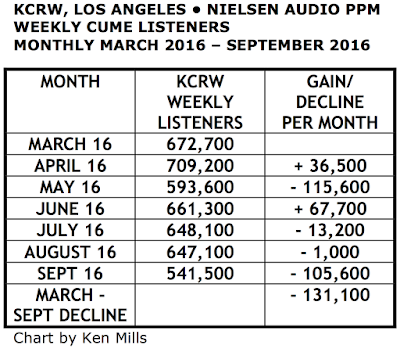I’ve heard that
phrase many times over my years in the business. It’s just as true today.
“Weekly Cumulative Persons” in Nielsen Audio reports is the official way to say
“Weekly Cume” and “Weekly Listeners.” (Nielsen Audio now also measures Daily
Cumulative Persons in PPM markets.)
Weekly Cume is a
powerful metric. It is the estimated number of people who enter your business
and stay for the minimum time (typically five minutes). Week cume is sort of a head count. It is similar
to “circulation” in the print world and “unique visitors” in digital usage
analysis.
I usually cite
Weekly Cume data for two reasons:
(1.) It is a
powerful metric.
(2.) As a
journalist, most Nielsen Audio data is not available to me. Stations, producers
and networks who are subscribers get much, much more information from Nielsen
Audio.
I am bringing up
Weekly Cume today because a couple of readers told me off-the-record that station folks don’t pay much attention to it. AQH is what they want and what they use. So, when you read my stuff please keep in mind, I am talking about Weekly Cume.
Several readers
told me confidentially that they were surprised by what I’ve been reporting the
last two days. They had no idea that
Weekly Cumes for some of the biggest NPR News stations had seen substantial
declines when I compared estimated Weekly Cume from March 2016 and September
2016.
Nielsen subscribers get
detailed information via Radio Research Consortium (RRC) such as quarter hourly listening in all hours and
dayparts, tune-ins, tune-outs, duration of listening. One station programmer told me NPR News
nationally has had 10 straight months of AQH growth in PPM markets. Well and
good, but the size of the “listener lake” in some places is getting smaller.
One reader pointed
out that picking six months is arbitrary and random. Yes it us. So is any other comparison over
time. I choose six months because it
would keep the continuity of the election cycle. Another reader pointed out
that ratings “are just numbers” and lack context. True, but this is what we’ve got.
I imagine when
I reported the declines, I surprised the folks at WBEZ because I did not hear back from them. I
have always had wonderful associations with folks at WBEZ.
A few years ago I did marketing work for Sound Opinions. Perhaps they didn’t know that their Weekly Cume has
fallen for six straight months.
A LOOK AT MORE STATIONS with SIMILAR PATTERNS
As
I mentioned in Wednesday’s story, 10 of 13 (77%) NPR News stations in the list
of the top twenty noncommercial stations ranked by Weekly Cume saw the number of weekly
listeners decline between March 2016 and September 2016. Nielsen Audio
estimated Weekly Cume data for 10 of 13 (77%) NPR News stations lost weekly
listeners. Four stations – WBEZ, WBUR, KPCC & KCRW combined lost almost
600,000 weekly listeners in the six month period. KPCC’s Weekly Cume dropped
21%, WBUR dropped 27%, WBEZ lost 22% and KCRW lost 19%.
I
choose to use WBEZ for a closer look yesterday in part because they are the
sole NPR News voice in the market. Therefore there likely are no competing
stations with same or very similar programming.
Today we have six month trends by month for KPCC, KCRW and WBUR. I’ve added a chart to WGBH to keep WBUR in
context.




























